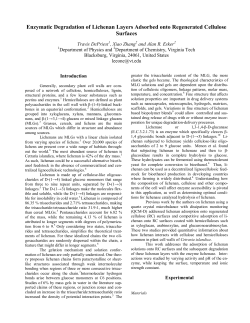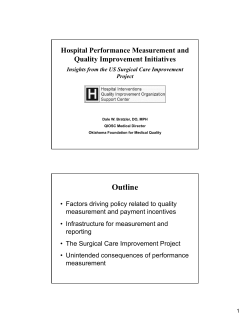
Streptomyces gulbargensis application in removal of blood stains
Indian Journal of Biotechnology Vol 8, July 2009, pp 280-285 Production of alkaline protease from Streptomyces gulbargensis and its application in removal of blood stains N Vishalakshi, K Lingappa*, S Amena, M Prabhakar and A Dayanand Department of Microbiology, Gulbarga University Gulbarga 585 106, India Received 1 August 2008; revised 12 January 2009; accepted 15 March 2009 The alkaline protease obtained from a newly isolated strain of Streptomyces gulbargensis was used for the washing of surgical instruments. The isolate showed β-haemolysis. Therefore, the isolate was employed for the production of thermo stable alkaline protease enzyme using wheat bran as the substrate under solid state fermentation. The characterization studies of the enzyme showed that it is active at 45°C and pH 9.0 with casein as the substrate. The wash performance analysis of blood stains on cotton fabrics and on surgical instruments showed an increase in the reflectance as the time increased with the enzyme treatment. The removal of blood stains completely was observed at 20 min incubation of cotton cloths and surgical instruments. Keywords: Alkaline protease, blood stains, surgical instruments, S. gulbargensis, wheat bran Introduction Surgery is a complex process performed by employing various surgical instruments. During surgery, the surgical instruments invariably come in contact with blood of the patients. If such instruments are not properly washed, it leads to contamination and foul smelling due to microbial degradation of blood and finally paving way to transmission of diseases to other patients and health care personnel. Hence, the surgical instruments and other medical devices, for reuse, must be cleaned with proper solutions. Cleaning not only avoids the transmission of diseases, but also forms an important aspect for the maintenance of hygiene and safety of surgical instruments. Usually the surgical instruments are washed or cleaned by sterilization or by using chemical steriliants. However, chemical steriliants can not remove microbes that usually get trapped behind the bioburden that is encrusted on or within surgical instruments. Therefore, this has spurred us to expand our efforts to identify a product that can be employed for the cleaning of surgical instruments. However, the recent cleaning technologies include enzymecontaining formulations and zeolite based detergents. Of these, the enzyme detergents often referred to as ______________ *Author for correspondence: Tel: 91 8472-263297; Fax: 91 8472-263206 E-mail: lingappak_micro@rediffmail.com “Green Chemicals”, are proving extremely useful in keeping a check on the environmental pollution1. Addition of alkaline protease to detergents considerably increases (35-40%) the cleaning effect (particularly in removing stains containing proteins, e.g., blood, cocoa, milk, eggs, and sauces) and increases the consumption of surface-active substances, thereby improving the ecological situation. Out of the vast pool of enzymes, proteolytic enzymes from microorganisms are the most widely exploited enzymes in the detergent industries world wide2,3. Proteases are present in all living beings and play an important role in normal and abnormal physiological conditions. Looking into the depth of microbial diversity, there is always a chance of finding microorganisms producing alkaline enzymes, which are suitable for the manufacture of “biocleaners”. Therefore, an attempt has been made to produce alkaline proteases, which can hydrolyse specifically haem as the substrate by employing a novel strain of Streptomyces gulbargensis. The enzyme can be used as an ingredient in the preparation of biocleaning agents especially for washing surgical instruments. Materials and Methods Microorganism and Growth Conditions Streptomyces gulbargensis sp. nov., was isolated and identified by 16S rRNA gene sequence and VISHALAKSHI et al: BLOOD STAIN REMOVAL BY ALKALINE PROTEASE OF S. GULBARGENSIS deposited in GenBank database under the accession number DQ3174114. The type culture/strain (DAS 131) was deposited at =CCTCC Ac No 206001; =KCTC Ac No 19179. The organism was collected from the Department of Microbiology, Gulbarga University and then studied for its ability to grow on skim milk agar (SMA) (HiMedia, Mumbai) medium and on blood agar plates, incubated at 37°C to determine potential protease enzyme5 and its caseinolytic and heamolytic activites. The strain was preserved at 4°C on starch casein agar (SCA) slants. The isolate was maintained as a spore suspension6. Fermentation Studies The production of proteases was carried out by using 25 g of wheat bran as the substrate under solid state fermentation. The contents of the flask were inoculated with 1 mL of inoculum (1×108 spores/mL) after autoclaving. The contents were mixed thoroughly by gently beating the flasks on the palm of the hand and incubated in a slanting position at 37°C for 7 d. After incubation, the substrates were analyzed for the production of proteases as described by Raimbult et al7. Extraction and Assay of Enzyme Activity After the fermentation, culture mass of the solid medium was extracted with 1:10 volumes of distilled water with shaking at 160 rpm (Remi) for 1 h at 25-30°C, centrifuged and supernatant was used as the crude enzyme extract for the assay. Protease activity of the culture mass extract was determined by modified method of Anson8. The reaction mixture contained 1 mL of 1% casein in an M 0.1 NaH2PO4 phosphate buffer (pH 7.5) and 1 mL of the crude enzyme solution. It was incubated at 37°C for 20 min and the reaction was stopped by adding 3 mL of 10% trichloroacetic acid. The absorbance of the liberated tyrosine in the filtrate was measured at 280 nm using a UV-Visible spectrophotometer (GENESYS 10 UV) against a standard tyrosine solution. One unit of protease activity was defined as the amount of enzyme which releases 1 µM of tyrosine per min under assay conditions. Ammonium Sulfate Precipitation Salt precipitation was carried out using 100 mL of the crude enzyme extract upto 70%. All the subsequent steps were carried out at 4°C. The resulting precipitate was collected by centrifugation at 281 10,000 rpm for 10 min at 4°C. The precipitate was dissolved in 50 mM Tris-HCl (pH 8.5) for further use. Characterization of Enzyme Activity Effect of pH Effect of pH on the stability of protease was studied as per the method of Adinarayana et al9 by incubating the enzyme with buffers covering the range of 4.0-10.0, different buffers (0.1 M) used were potassium phosphate (pH 4.0-7.5), Tris-HCl (pH 8.08.5) and sodium bicarbonate (pH 9.0-10.0). Enzyme samples were added to different buffers and incubated at 45°C for 20 min and assay was carried out as described by Adinarayana et al9. Effect of Temperature The enzyme samples were incubated at various temperatures ranging from 0-80°C, at pH 9.0. After 20 min, the assay was carried out as described by Adinarayana et al9. Evaluation of Washing Performance of Enzyme Application of protease (5000 µ/mL) as a detergent additive was studied on white cotton cloth pieces (15×15 cm) stained with blood9,10. The stained cloth pieces were taken in separate trays. The following sets were prepared and studied: Tray with distilled water (100 mL) + blood stained cloth Tray with distilled water (100 mL) + blood stained cloth + 1 mL of commercial detergent (7 mg/mL) Tray with distilled water (100 mL) + blood stained cloth + 1 mL of commercial detergent (7 mg/mL) + partially purified enzyme Tray with distilled water (100 mL) + blood stained cloth + partially purified enzyme. The above trays were incubated at 40°C for 25 min. The cloth pieces were taken out from each set at regular intervals of 5 min, rinsed with water, dried and visually examined. Untreated cloth pieces stained with blood were taken as control. Evaluation of Washing Performance of Enzyme with Detergent on Surgical Instruments Various surgical instruments stained with blood were taken and subjected to washing performance for 20 min at 40°C by commercial detergents and the enzyme7. Visual observation was made for the extent of blood stain removal from the instruments after 20 min. 282 INDIAN J BIOTECHNOL, JULY 2009 Comparative Evaluation of Washing Performance of Enzyme Detergent with Commercial detergents Washing performance of the enzyme with detergent was compared with that of commercial branded detergents like Ariel, Henko, Nirma, Rin Advance, Surf Excel and Tide9 . Effect of Temperature The results of the studies on the effect of the temperature on enzyme activity are presented in Fig. 4. The temperature kinetics of the enzyme suggests that the enzyme activity increased sharply from 0 to 45°C, followed by a sudden decline Results and Discussion The strain of S. gulbargensis was selected for the production of protease on the basis of formation of clear zone near the vicinity of the colony, visible to naked eyes (Figs 1a & b). The fermentation studies indicated that the enzyme production was maximum at 120 h of fermentation (Fig. 2). The enzyme was extracted from fermented bran and partially purified by 70% ammonium sulphate and used for further studies. Enzyme Activity Effect of pH The results on the effect of pH on the enzyme activity are presented in Fig. 3. The pH kinetics of the enzyme activity revealed that the activity increased from pH 5 to 10. The optimum pH recorded was 9.0 for maximum activity. Fig. 2—Protease production under solid state condition using wheat bran. Fig. 3—pH profile of alkaline protease Fig. 1—(a) β-haemolysis shown by (b) Proteolytic activity of S. gulbargensis S. gulbargensis; Fig. 4—Temperature profile of alkaline protease at pH 9.0 VISHALAKSHI et al: BLOOD STAIN REMOVAL BY ALKALINE PROTEASE OF S. GULBARGENSIS Fig. 5—Evaluation of crude enzyme for washing of blood stains from cloths. 283 284 INDIAN J BIOTECHNOL, JULY 2009 thereafter. The study indicated that the enzyme from S. gulbargensis was maximally active at 45°C. Evaluation of Enzyme for Washing Performance Alkaline proteases are employed primarily as cleansing additives. The results (Fig. 5) of evaluation of enzyme for washing performance revealed that the blood stains on the cloth pieces remained as it is even after 30 min of rinsing in the case of controls and commercial detergents. Blood stains were completely removed from the cloths after rinsing them with a combination of detergent and partially purified enzyme for a period of 20 min, whereas it was removed after 25 min when rinsed with partially purified enzyme alone. These results clearly indicated that the enzyme is stable as an ingredient in the presence of detergents. presented in Fig. 6. After an incubation of 20 min, stains could not be removed completely with detergent alone, while the combination of the enzyme with commercial detergent removed the blood stains from the surgical instruments very effectively. Comparative Evaluation of Washing Performance of Enzyme Detergent with Commercial Detergents Of all the branded detergents, Ariel and Tide removed blood stains after 20 min of rinsing which is at par with the commercial detergents supplemented with partially purified enzyme (Fig. 7). Evaluation of Washing Performance of Enzyme Detergent on Surgical Instruments The evaluation of the washing performance of the enzyme detergent on the surgical instruments is Fig. 6—Evaluation of washing performance enzyme+detergent on surgical instruments. of the Fig. 7—Comparative evaluation of washing performance of the enzyme detergent with commercial detergents on cloths. VISHALAKSHI et al: BLOOD STAIN REMOVAL BY ALKALINE PROTEASE OF S. GULBARGENSIS The enzyme obtained in the present study is less expensive as it is produced on the agricultural wastes, however, its economics for commercial exploitation has to be worked out. The enzyme is stable at alkaline pH. In the present study, the enzyme showed promising results in the removal of blood stains from cloths and surgical instruments and indicated that it is substrate specific to heam. Therefore, these properties of the enzyme indicated the possibilities of its use in the manufacture of surgical cleaning detergent industry. Acknowledgement The authors would like to thank The Chairman, Department of Microbiology, Gulbarga University, Gulbarga, for kindly providing the strain Streptomyces gulbargensis and laboratory facilities. References 1 2 Kumar G C & Parrack P, Novel enzyme-based detergents: An Indian perspective, World J Microbiol Biotechnol, 19 (2003) 243-246. Leisola M, Jokela J, Pastinen O & Turuen O, Industrial use of enzymes, in Industrial enzymology, edited by T Godfrey & S West (Macmillan, U K) 1996. 3 285 Showell M S, Enzyme detergents, in Encyclopedia of bioprocess technology. Fermentation, biocatalysis and bioseparation, vol 2, edited by Flickinger & S W McDrew (Wiley, New York) 1999, 958-971. 4 Dastager S G, Li Wen-Jun, Dayanand A, Mudgulkar B, Sulochana et al, Streptomyces gulbargensis sp. nov., isolated from soil in Karnataka, India, Antonie van Leeuwenhoek, 91 (2007) 99-104. 5 Gupta R, Beg Q K, Khan S & Chauhan B, An overview on fermentation, downstream processing and properties of microbial alkaline proteases, Appl Microbiol Biotechnol, 60 (2002) 381-395. 6 Hopwood D A, Bill M J, Charter K F, Kieser T, Bruton C J et al, Genetic manipulation of Streptomycetes: A laboratory manual, (John Innes Foundation, Norwich, U K) 1985. 7 Raimbault M, General and microbiological aspects of solid state fermentation, Electronic J Biotechnol, 3 (1998) 174-188. 8 Anson M L, The estimation of pepsin, trypsin, papain and cathepsin with hemoglobin, J Gen Physiol, 22 (1938) 79-89. 9 Adinarayana K, Ellaiah P & Prasad D S, Purification and partial characterization of thermostable serine alkaline protease from a newly isolated Bacillus subtilis PE-11, AAPS Pharm SciTech, 4,4 (2003) Article 56. 10 Najafi M F, Deobagkar D & Deobagkar D, Potential application of protease isolated from Pseudomonas aeruginosa PD100, Electronic J Biotechnol, 8 (2005) 197-203.
© Copyright 2025




















